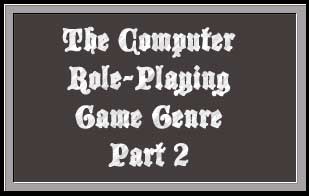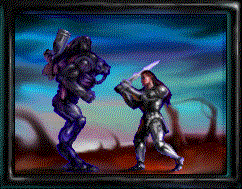Action CRPGs
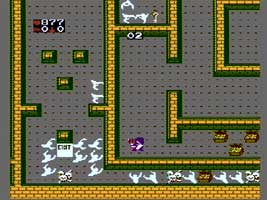 Dungeon
hack or action CRPGs that concentrate purely on combat started with the arcade
game Gauntlet (1985) in which the player choose one of four D&D
style characters and then either by himself or with a partner fought through
100 dungeon levels. The player could find keys, potions and treasure which
enabled him to advance to new areas, power up his character or added to the
players score.
Dungeon
hack or action CRPGs that concentrate purely on combat started with the arcade
game Gauntlet (1985) in which the player choose one of four D&D
style characters and then either by himself or with a partner fought through
100 dungeon levels. The player could find keys, potions and treasure which
enabled him to advance to new areas, power up his character or added to the
players score.
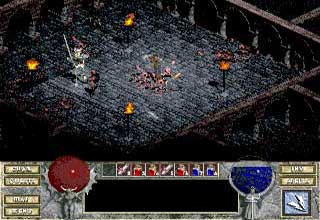 The
Action CRPG sub genre was reborn with Diablo (1996) by Blizzard Entertainment
and the game play was much the same as in Gauntlet. The player had a choice
of either warrior, sorcerer or rogue characters which could use different
weapons, spells and equipment and could level up in power. The player battles
his way through the 16 randomly created dungeon levels. On consoles it could
be played by up to 3 players. It was the first CRPG that was heavily moded.
The game was followed by Diablo II (2000) with this time five characters
to choose from and was played heavily in multiplayer mode on the internet.
The
Action CRPG sub genre was reborn with Diablo (1996) by Blizzard Entertainment
and the game play was much the same as in Gauntlet. The player had a choice
of either warrior, sorcerer or rogue characters which could use different
weapons, spells and equipment and could level up in power. The player battles
his way through the 16 randomly created dungeon levels. On consoles it could
be played by up to 3 players. It was the first CRPG that was heavily moded.
The game was followed by Diablo II (2000) with this time five characters
to choose from and was played heavily in multiplayer mode on the internet.
NOX (2000) was basically a Diablo clone which had a slightly original background plot - the player is summoned from the 20th Century to be the saviour of Nox and are the only living being on Nox that may touch a magic Orb in the possession of the wicked-evil queen of the undead - Hecubah. However, it had more detail and some humour.
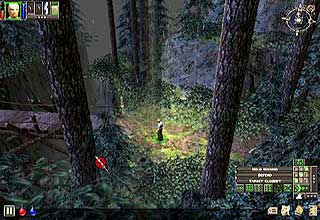 Dungeon
Siege (2002) developed by Gas Powered Games is another combat orientated
CRPG. The design innovations for this sub-genre are that allows the player
to control a party rather than a single character. Strategic elements to the
gameplay for placing different classes in combat have been adopted from the
Real Time Strategy genre. The main technological development is that a giant
3D world plane is rendered in real time without any screen loads. The game
can also be played multiplayer on the internet. Dungeon Siege has been heavily
moded by its fans to get round shortcomings such as character progression
ending at a certain point.
Dungeon
Siege (2002) developed by Gas Powered Games is another combat orientated
CRPG. The design innovations for this sub-genre are that allows the player
to control a party rather than a single character. Strategic elements to the
gameplay for placing different classes in combat have been adopted from the
Real Time Strategy genre. The main technological development is that a giant
3D world plane is rendered in real time without any screen loads. The game
can also be played multiplayer on the internet. Dungeon Siege has been heavily
moded by its fans to get round shortcomings such as character progression
ending at a certain point.
Non-Fantasy Themed CRPGS
There have been non-fantasy role-playing games such as Traveller by Game Designers' Workshop. Traveller was a sci-fiction RPG system, which allowed the creation of a future galaxy in which the player had adventures trading and exploring. Strangely, the universe background history, alien races and robots were tacked on later and the technological system meant the player would use modern guns or even swords rather than future weaponry. TSR's Gamma World was a thin rule set that was set in a post nuclear apocalyptic world of radiated mutants, but non-were as commercial successful as the fantasy worlds originally inspired by Tolkein.
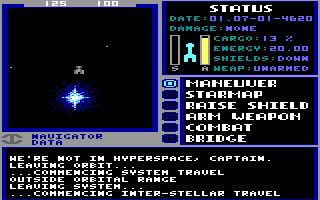 Binary
System's Starflight (1986) was a science-fiction role-playing game.
The plot was that the homeworld has exhausted its resources and so the player
must equip a starship and find a new world to live. Utilizes an ahead-of-its-time
technology for universe creation based on fractal surface generation and had
'real-time' game-play. Features included exploring hundreds of galaxies each
with several planets, looking for minerals and artefacts. The player interacted
and barted with alien races, each with a unique language and culture.
Binary
System's Starflight (1986) was a science-fiction role-playing game.
The plot was that the homeworld has exhausted its resources and so the player
must equip a starship and find a new world to live. Utilizes an ahead-of-its-time
technology for universe creation based on fractal surface generation and had
'real-time' game-play. Features included exploring hundreds of galaxies each
with several planets, looking for minerals and artefacts. The player interacted
and barted with alien races, each with a unique language and culture.
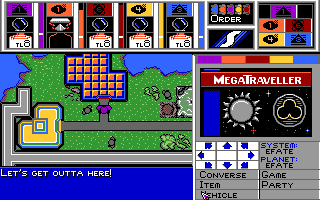 The
economic strategy elements and exploration would be continued in the strategy/action
game Elite (1987). The second MegaTraveller version of the RPG rules set was
used for two CRPGs; MegaTraveller 1: The Zhodani Conspiracy (1990)
and MegaTraveller 2: Quest for the Ancients (1991), they were technologically
poor compared to their contemporaries and although gameplay includes a mixture
of both plot and do your own exploration/bartering to make money, they rapidly
became tedious. Strangely, the familiar Star Trek world has not being used
for a CRPG, although the simulation/adventure Star Trek: The Next Generation:
A Final Unity (1995) and the shooter Star Trek: Klingon Academy
(2000) come close.
The
economic strategy elements and exploration would be continued in the strategy/action
game Elite (1987). The second MegaTraveller version of the RPG rules set was
used for two CRPGs; MegaTraveller 1: The Zhodani Conspiracy (1990)
and MegaTraveller 2: Quest for the Ancients (1991), they were technologically
poor compared to their contemporaries and although gameplay includes a mixture
of both plot and do your own exploration/bartering to make money, they rapidly
became tedious. Strangely, the familiar Star Trek world has not being used
for a CRPG, although the simulation/adventure Star Trek: The Next Generation:
A Final Unity (1995) and the shooter Star Trek: Klingon Academy
(2000) come close.
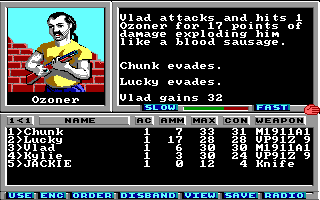 Many
think Wasteland (1987) is the best CRPG of all time. Wasteland was
set in a future world after the nuclear holocaust of World War III. The plot
was to guide a band of Desert Rangers from town to town, gradually uncovering
a sinister plot that threatens what is left of mankind. This storyline was
deep and was full of dark hidden jokes and used familiar elements from American
life mixed with the horror of nuclear war. Players actually replayed Wasteland
as although the final objective remains the same there were a number of ways
to complete it.
Many
think Wasteland (1987) is the best CRPG of all time. Wasteland was
set in a future world after the nuclear holocaust of World War III. The plot
was to guide a band of Desert Rangers from town to town, gradually uncovering
a sinister plot that threatens what is left of mankind. This storyline was
deep and was full of dark hidden jokes and used familiar elements from American
life mixed with the horror of nuclear war. Players actually replayed Wasteland
as although the final objective remains the same there were a number of ways
to complete it.
Wasteland used an original skill-based system in conjunction with traditional character attributes to achieve goals and get past obstacles rather than a character class system. The player instead of levelling up got points to use on attributes and skills through using them. This meant that the player could develop his character to be the way he wants it to be.
Wasteland interface was very functional and in the DOS version the player could program macros to do functions rather than go through a menu system in the days before pointing devices were common.
The games play balance was good being neither to hard or easy, so that advancement from one area prepares the player quite well for the next. However, in some places random monsters pop up out of nowhere and are seemingly endless, there were a few sequences in which the player could get stuck in a event loop and was forced to go back to an earlier save.
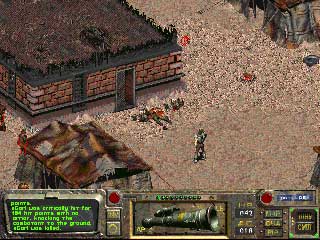 A
decade later, Wasteland was followed up with Fallout (1997) and Fallout
2 (1998). The Fallout games use all the design elements of Darklands,
but does it very well mixing a strong plot and side quests with random encounters
to produce a believably open ended, non-linear and immersive world in which
the player can build a character with the skills he needs to play the game
in his style. The player never feels lost in Fallout and knows what to do
next in order to progress the story or can simply engage in exploring and
side quests that improve his character.
A
decade later, Wasteland was followed up with Fallout (1997) and Fallout
2 (1998). The Fallout games use all the design elements of Darklands,
but does it very well mixing a strong plot and side quests with random encounters
to produce a believably open ended, non-linear and immersive world in which
the player can build a character with the skills he needs to play the game
in his style. The player never feels lost in Fallout and knows what to do
next in order to progress the story or can simply engage in exploring and
side quests that improve his character.
Fallout 2 is a much bigger game with a much larger game world and many more side quests to do, so it takes months to complete rather than days. The landscape is more diverse and includes Fallout's vaults, caves and primitive cities, which include the gangster run Vegas-esque New Reno and the futuristic Vault City with its new society.
The first game perhaps has the stronger story and plot it sets itself in its own vision of how humanity would look after an atomic war during the 1950s Cold War. The world of Fallout is split into tiny societies ruled by tyrants and insane religious teachings corrupt the hearts of desperate people, and whole communities live in fallout shelters that have no contact with the outside world. Like all good science-fiction, Fallout is not really a story about the future but allows you to see your own society from a different perspective. The second game is set in an established wasteland, although there are some continuity breaks, it has the same atmosphere and dark humour but the plot contains a pastiche of references to all the post-nuclear war movies including the Mad Max series, references to popular culture such as government conspiracies and aliens from the X-Files. The quests have that traditional adventure gaming humour but it is sort of Monkey Island on acid. When the player first goes into the Mutant village, they are playing a card game much like the then popular Magic the Gathering, and you realise what a dumb game it really is. As you are playing the game, it makes you smile in side and think at the same time.
Fallout creates a great atmosphere through the attention to graphic detail with burned-out buildings and cars, barren landscapes and the cute 1950's style 'Pip-Boy' character from a future that never was. The games intro is considered one of the best ever as it is profound and touching but simple. The game uses cut scenes that do not intrude on the game but help give a sense of something important happening in the plot. The game does not have music as such except for the opening sequence, in which a crackly old 40's ballad sets an eerie contrast to the devastation and takes you back to World War Two. The game uses ambient sound effects combined with various drumbeats or sitar-plucking that wander into the background which helps set the atmosphere of the wasteland.
Fallout originally was going to have a tie into the Generic Universal Role-playing System (GURPS) by Steve Jackson Games, but the setting and dark humour of the game sent them scurrying for cover. In fact, the game is highly moral and does not use cheap titillation to draw in the lowest denominator of players, although it does deal with 'mature subject matter' and shows what a shocking world Fallout is in a no hold bars way. In almost all situations the game presents the player with choices, he can be a good guy or a bad guy or even take a grey option, bringing economic development and peace to the wasteland or join a Mafia family or be a slaver. The game heavily rewards the good player and punishes bad actions. Such deeds change the characters reputation, which effects how NPCs view and treat the player character. (I have seen a walk through of how to do Fallout 2 the evil way!) The endgame sequence changes depending on which quests are completed and shows the consequences of the player's actions.
The character development is original and uses a skill based system rather than a character system. 'Perks' which are extra-special abilities are bestowed every 3 or 4 skill levels or after doing certain quests. Skills can be a bonus to generic situations such as long ranger accuracy in combat or could increase the characters carrying capacity independent of strength. They are sometimes also useful in certain quests such as being able to disarm a booby trap and then unlock a safe, however the player could always get the combination with more effort. Virtually any character development path was entirely playable, the player could create a physically strong idiot character and hope no enemy will be too tough for him. Players have even finished the game using a purely diplomatic character although that would involve running away from most random encounters. The Perk choices were not balanced for gameplay but this was part of the fun discovering which were the best skills. The system is used in the fantasy meets technology game Arcanum: Of Steamworks & Magick Obscura (2001) but although it has an original setting is not as good as Fallout in delivering morality to the plot or balancing character skill choices.
A great game to be actual playable needs decent quality assurance and both games were beset by bugs that cause crashes although patches have helped here greatly (The player had to restart after applying!). Fallout 2 also suffers from problems with its dialogue. In some places the dialogue branches do not match which lead to the wrong response from NPCs. Some of dialogue was also badly written. A few sub-quests were only semi-completed or badly thought out - in the first town this is clearly a sub quest beginning with two robber brothers but it does not go anywhere which left me confused.
The design of the interaction with the NPCs in the player's party was poor. In the original game they could not wear armour or gain levels ensuring they would die as the game got harder and tended to go hide in a corner once combat began as the player had no means to order them about. The player also had to use his steal skill to swap items. These problems were solved in Fallout 2 which introduced a party management menu and it gave them more character as well, but they still tended to stand in front of the players character when he was firing his mini-gun on full automatic or block doorways.
The combat system is impressive and deals with everything from hand-to hand combat, spears and rocking throwing up to future tech plasma gun and bombs. The combat system used a points system of actions and did not involve a switch in perspective. The limited supply of ammunition helped balance the weapons system although in Fallout the player got too powerful too fast. Fallout 2 was balanced by the slow introduction of high tech energy weapons but they are also made weak at penetrating the latest armour types compared to old fashioned ballistic weapons, which makes a rather difficult jar to the games believability.
Game balance was out in the first Fallout as it had a hard game time limit and the player rapidly became very powerful. However, both games are non-linear in that they can be finished in only a few hours gameplay as only a few quests have to be completed, and if the player cheats in Fallout 2 he can make his character extremely powerful by going straight to a cache of high-tech weapons and armour. However, the game cleverly makes the tougher quests and random creatures of the wasteland turn up later in the game as the player becomes more powerful. It is not possible to complete all the quests as some paths are removed or added if another preceding quest is completed in a certain way but by the end of the plot, only one path is available.
The great game design achievement of the Fallout series was to create a believable world from a mixture of random encounters and scripted plots in set locations on a single CD-ROM. The player travelled on a map of the wastelands displayed on his personal laptop - the PIP BOY 2000, sometimes discovering hidden locations by being given their location by NPCs or actually finding them, these could be whole cities or a secret vault shelter. The random encounters could be dangerous animals, bandits, traders or special events. Some of the random encounters were extra special such as a funny situation and contained scripted elements. However these encounters were very rare, so no player would ever see them all. The game (after the patches were applied) cleverly increased the difficulty to keep up with the players level. The game used an isometric view of the player's character and world once an encounter happened or a location was reached for speech, trade or exploration. The game repeated graphics of caves, vault corridors, houses, burned out cars and NPCs but did it well so it was hardly noticeable. Fallout was Darklands done well at last.
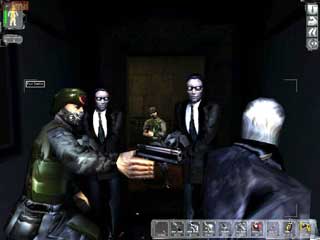 The
Cyberpunk literature started by William Gibson's novel Neuromancer, which
created the concept of cyber-space has been the inspiration for the theme
of a number of games. Deus Ex (2000) by Ion Storm is set in such a
cyber punk world. The design team included people who worked on Doom
(1993) and Ultima Underworld and uses the engine from the Unreal
(1998) First Person Shooter (FPS). However, it is a very original game
and mixes different game genre and styles with a mixture of a 3D RPG, FPS
a strong storyline of an adventure game and the sneak tactics of the action
game Thief: The Dark Project (1998) by Looking Glass. The game uses
a first person prospective in a 3D world and camera sequences are sometimes
interspersed to transition the gameplay or expose new story elements.
The
Cyberpunk literature started by William Gibson's novel Neuromancer, which
created the concept of cyber-space has been the inspiration for the theme
of a number of games. Deus Ex (2000) by Ion Storm is set in such a
cyber punk world. The design team included people who worked on Doom
(1993) and Ultima Underworld and uses the engine from the Unreal
(1998) First Person Shooter (FPS). However, it is a very original game
and mixes different game genre and styles with a mixture of a 3D RPG, FPS
a strong storyline of an adventure game and the sneak tactics of the action
game Thief: The Dark Project (1998) by Looking Glass. The game uses
a first person prospective in a 3D world and camera sequences are sometimes
interspersed to transition the gameplay or expose new story elements.
The player rather than creating a character takes the role of JC Denton, a secret agent for UNATCO anti-terrorist agency, which is more like an adventure game than a strategy game. The character has been augmented by nano-technology and character development is by upgrading the character's cyber parts to improve different skills in specialized areas like improved night vision or striking force.
The twisting conspiratorial storyline of Warren Spector is what makes the game gripping and immersive. NPCs are given strong personalities for instance the player character's brother is a humanist and a freedom fighter and tends to avoid casualties wherever possible. He is utterly self-less in striving for the greater good and whilst charismatic is very secretive. Many of the game characters are just as complex. The plot takes the player around the globe with detailed settings in New York, Paris and Hong Kong.
The game storyline is linear and does not have widely differing storylines based on how the player carries out the missions but has three different possible endings that the player must make at the end of the game. It is the gameplay that makes Deus Ex non-linear and makes it more like a CRPG than a FPS as it offers alternative routes to every problem presented. Deus Ex allows the player to make moral decisions such as who he kills. The player can pick electronic locks, or hack terminals to find the entry code. The player could also use brute force and use explosives to blow the door off its hinges, which will also bring the guards running. The player can sneak passed guards, kill everyone in sight or the weaponry allows the player just to stun enemies. These possibilities allow different styles of play to be used. The game does respond to the player's decisions by the reaction of NPCs to the characters reputation. Some will be pleased if the player kills a lot and some will be if restraint was shown. However, the player must still complete the same missions in the same settings.
Deus Ex also allows a high degree of interaction with the 3D world, nearly every object in the whole game can be acted upon. Chairs can be moved and destroyed. Lamps can be turned on and off or destroyed!
The game has an interesting mix of weapons that can kill or stun including taser stunners, gas grenades, sniper rifles, flamethrowers, rocket launchers, explosives, and many different stealth weapons. This variety allows a player to play the game according to his or her own style, and are upgradeable and well balanced with the game.
Player gripes about Deus Ex include long load times, a poor Inventory system hammy voice acting, shortage of ammo and the player dies too often even on the easy setting. The AI is stupid and enemies do not notice the player while staring precisely in his direction.
Desus Ex gets strong and violently opposed gamer reactions to it - from it is a new way of designing computer games that has completely shattered all preconceptions to an unplayable, unbalanced, unrealistic and confusing mess. The game has excellent game art and music to the view that they are dreadful. The story is art but some point out that Spector's claim that all games before it were either "good guy Vs bad guy" is nonsense as in Desus Ex the player is still saving the world from evil. Deus Ex: Invisible War (2003) is the sequel and has had the gameplay simplified to appeal to a wider audience in certain areas although the player can still update his characters body with biotech parts there is no character stats or character progression so the CRPG element has been removed. This must be the final comment on Desus Ex's ground breaking design!
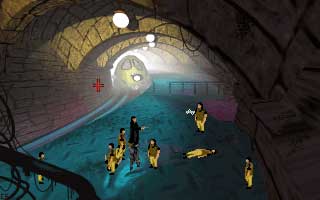 There
have been a number of pen and pencil RPGs with a horror setting and include
Call of Cthulu and White Wolf's Vampire the Masquerade. An interesting
horror and cyberpunk theme mix was used in BloodNet (1993) by Microprose.
The game also mixed genres and had CRPG character progression and skills but
used an adventure style flat graphic interface. Vampire: The Masquerade
- Redemption (2000) by Nihilistic Software allows the player to role-play
a vampire using White Wolfs RPG system. The plot follows a war between 13
vampire clans through history starting in Medieval Prague and Vienna and then
moves to Modern day London and New York. The game includes tools so the player
can create a multiplayer quest.
There
have been a number of pen and pencil RPGs with a horror setting and include
Call of Cthulu and White Wolf's Vampire the Masquerade. An interesting
horror and cyberpunk theme mix was used in BloodNet (1993) by Microprose.
The game also mixed genres and had CRPG character progression and skills but
used an adventure style flat graphic interface. Vampire: The Masquerade
- Redemption (2000) by Nihilistic Software allows the player to role-play
a vampire using White Wolfs RPG system. The plot follows a war between 13
vampire clans through history starting in Medieval Prague and Vienna and then
moves to Modern day London and New York. The game includes tools so the player
can create a multiplayer quest.
Japanese CRPGs
CRPGS came late to Japan the land of the console and they would give the genre a unique style all of their own. Japanese produced CRPGs would be the staples of Nintendo, Sega, and Sony Playstation platform and would prove to be critical in determining which consoles would survive.
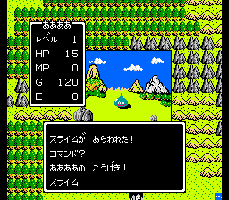 In
1986 Enix released Dragon Quest for the MSX personal computer and Nintendo
Famicon in Japan, and was released in the US as Dragon Warrior in 1989
for the Nintendo Entertainment System. Dragon Quest would become for the Japanese
the originator of the genre and players would use the term "DraQue"
to refer to any RPG system including pen & paper types.
In
1986 Enix released Dragon Quest for the MSX personal computer and Nintendo
Famicon in Japan, and was released in the US as Dragon Warrior in 1989
for the Nintendo Entertainment System. Dragon Quest would become for the Japanese
the originator of the genre and players would use the term "DraQue"
to refer to any RPG system including pen & paper types.
In Dragon Quest, the player's character was moved in a top down view of the world, but enemies were fought for a first-person perspective in a turn based system controlled through menu options. Later versions increased the complexity and Dragon Quest II (1987) made the game a party quest, whilst Dragon Quest III (1988) allowed the player to recruit new party members and change character classes.
Dragon Quest III on release made national headlines as children played truant from school to buy the game and lines reached several city blocks. The Japanese Diet or parliament decreed that future Dragon Quest games could only be released on Sundays or holidays. Dragon Quest/Warrior 7 released in 2001 was the best selling PlayStation game of all time in Japan and the first in the Dragon Warrior series to come to North America since Dragon Warrior 4 for the NES.
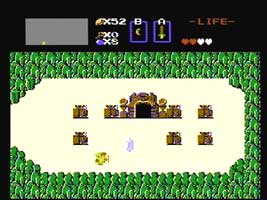 Nintendo's
Legend of Zelda or "Zelda no Densetsu" (1987) for the NES.
Although it had an arcade gameplay style, the players Character an Elf called
Link not only fought monsters but met people who wanted to help him. The series
has continued to the present with The Legend of Zelda: The Wind Waker
(2002) on Gamecube.
Nintendo's
Legend of Zelda or "Zelda no Densetsu" (1987) for the NES.
Although it had an arcade gameplay style, the players Character an Elf called
Link not only fought monsters but met people who wanted to help him. The series
has continued to the present with The Legend of Zelda: The Wind Waker
(2002) on Gamecube.
 Squaresoft's
Final Fantasy series began in 1987 on the NES. The player got a choice
of four characters from six classes and fought monsters that suddenly appeared
on the world map. Final Fantasy II (1988) actually simplified the play
of the game by just giving the player a party of four characters. The Final
Fantasy Legend (1989) on the Gameboy advanced play with a choice of 8
different characters and choose quests to go on. Final Fantasy IV (1991)
was originally released on the Super Famicom/Super NES and was the first to
use the Active Time Battle system (ATB). The advantage for the player was
that once an enemy was defeated the next character would switch to another
enemy, and not thin air.
Squaresoft's
Final Fantasy series began in 1987 on the NES. The player got a choice
of four characters from six classes and fought monsters that suddenly appeared
on the world map. Final Fantasy II (1988) actually simplified the play
of the game by just giving the player a party of four characters. The Final
Fantasy Legend (1989) on the Gameboy advanced play with a choice of 8
different characters and choose quests to go on. Final Fantasy IV (1991)
was originally released on the Super Famicom/Super NES and was the first to
use the Active Time Battle system (ATB). The advantage for the player was
that once an enemy was defeated the next character would switch to another
enemy, and not thin air.
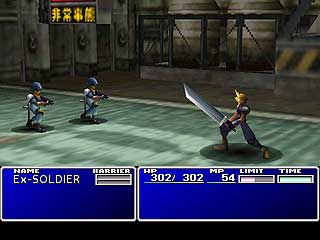 Square
with Final Fantasy VII (1997) broke with Nintendo and developed the
game for the new Playstation rather than the Nintendo 64. The success of the
game the first in 3D of the series ended Nintendo's market domination of the
console market and made the Playstation the best selling console. Square spent
a fortune on advertising and FF7 rocketed to the top of the charts upon its
release. Until Final Fantasy, RPGs had not been 'system-sellers' which had
always being mascot platformers or popular arcade ports.
Square
with Final Fantasy VII (1997) broke with Nintendo and developed the
game for the new Playstation rather than the Nintendo 64. The success of the
game the first in 3D of the series ended Nintendo's market domination of the
console market and made the Playstation the best selling console. Square spent
a fortune on advertising and FF7 rocketed to the top of the charts upon its
release. Until Final Fantasy, RPGs had not been 'system-sellers' which had
always being mascot platformers or popular arcade ports.
The fantasy world is not Tolkein-esque but takes place in a post-modern, sci-fi world where high technology reigns and robots and bio-engineered mutants weirdly co-exist with goblins and dragons! The style is Japanese anime style with wild haircuts and large eyes. The styles shift frequently, from the blocky and faceless placeholders the player sees during overworld navigation to the dark and detailed - Blade Runner-esque battle models. The series is aimed at Japanese youths in their early teens rather than the early 20s of Western CRPG fans but has a cult anime following in the west amongst older players.
All Japanese CRPGs have typically a linear storyline and FF7 played more like a book rather than the latter movie style of games like Metal Gear Solid and had even larger amounts of text coming up in blue windows, than was the norm for such Japanese CRPGs. The story is also complex and Sony unlike Nintendo did not censor the material so it got some PG-13 language and themes. However, not all arcade players had the attention span to cope with this. The game was not translated very well with some grammatical slip ups such as "Off course!". All your base are belong to us! There is no spoken voice in the game and all the music is mostly MIDI, not Redbook audio, with only one battle music theme for every battle except bosses or Chocobos.
Gameplay is no different from any other Japanse CRPG and follows the pattern of wander around performing tasks and solving puzzles, fighting random enemies for experience and items and find a critical juncture to learn a little bit more about the plot. Then fight a boss and learn some more plot, then move to the next area, wash and repeat. The gameplay is therefore not too different from Western CRPGs. Character progression is balanced so the player does not have to do side quests to defeat bosses. The plot has some depth as there two characters with fully developed back-stories that the player does not have to meet to finish the game. The Japanese variation on side quests is the mini-game and these including a racing game, strategy game, and various gambling games. Battles can occur randomly whilst wandering around the map or with a boss, which yields key items and plot points. One very Japanse CRPG combat innovation is the 'Limit' gauge if during a battle a character is attacked this goes up and when finally filled the Character can perform special 'Limit Break' attacks.
Each game character wields a certain type of weapon (sword, gun, megaphone) and better equipment and armour becomes available as the player progresses through the game. Magic is handled by "Materia", which can be placed in the character item slots and allows characters to use magic and summon spells, and do useful things like steal items, or transform enemies. If one character uses a Materia enough, they become proficient in it and can access more powerful spells. This is different from Western CRPG Magic use that tend to have one or two poor combat types that specialize in magic and cast spells from the rear of the party. In FF7, every character could be customised by how the player assigns the Materia.
Although FF7 got high praise for it cinematic scenes and battle graphics the bulk of the game consists of moving a crude polygon model of the player's character around interactive 2D backgrounds. Although in the US version arrows were put above the level exits it is still difficult to see in the low resolution PSX how to navigate across the map.
Final Fantasy VIII (1999) introduced a few new features such as a new magic system and the player must draw magic spells from enemies or "draw points" scattered around the game world and store them in your inventory. Another major change was the graphical transition to realistically proportioned characters, as opposed to the dominating "super-deformed" style of the Japanese RPGs, which was presumably to make the series appeal to a wider international audience.
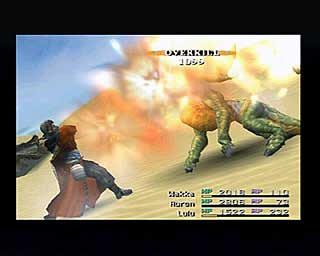 Final
Fantasy X (2001) by Square Electronic Arts LLC for Playstation 2, was
markedly different in style with less dark and more fun characters and story
than previous games in the series. However, some players disliked the story
and thought it had too many gaps and holes. FF X replaced the Active Turn
Battle system with a new combat system that allows players to choose their
characters' actions and any available character may be substituted for the
current member. Players are also given a bar on the side of the combat display
to study the combat turn order. These changes gave a harder and more cerebral
combat system. The character upgrading system now uses a sphere grid, and
sufficient ability points from fighting monsters moves the character a node
on the sphere grid. The player must activate the node using items dropped
by the monsters. Each character has different skills on the node such as thief
skills for Rikku and health and strength builders for Auron. Later in the
game, the player will find items that let the party move to completely new
areas of the sphere grid, or even to activate nodes from a distance. Unlike
many of the previous games in this series, FF X put less emphasis on character's
weapons and armour and more on internal abilities, although weapons could
be customised to do magic attacks or give resistance to certain attacks.
Final
Fantasy X (2001) by Square Electronic Arts LLC for Playstation 2, was
markedly different in style with less dark and more fun characters and story
than previous games in the series. However, some players disliked the story
and thought it had too many gaps and holes. FF X replaced the Active Turn
Battle system with a new combat system that allows players to choose their
characters' actions and any available character may be substituted for the
current member. Players are also given a bar on the side of the combat display
to study the combat turn order. These changes gave a harder and more cerebral
combat system. The character upgrading system now uses a sphere grid, and
sufficient ability points from fighting monsters moves the character a node
on the sphere grid. The player must activate the node using items dropped
by the monsters. Each character has different skills on the node such as thief
skills for Rikku and health and strength builders for Auron. Later in the
game, the player will find items that let the party move to completely new
areas of the sphere grid, or even to activate nodes from a distance. Unlike
many of the previous games in this series, FF X put less emphasis on character's
weapons and armour and more on internal abilities, although weapons could
be customised to do magic attacks or give resistance to certain attacks.
The interface is more streamlined than the previous titles and allows the player to sort through lists with ease. The world view is uncluttered and an unobtrusive mini-map marks the players destination and makes for easy navigation. FF X introduced voice acting that reduced reading and gave the game more character. Although the graphics are an improvement over previous games in the series and has an active camera view that pans and angles itself as the characters travel to showcase as much of the landscape as possible. However, some players thought the games graphics were not as good as other PS2 titles such as Metal Gear Solid 2 which was released at the same time.
Final Fantasy: Crystal Chronicles (2003) by Square Enix introduced a multiplayer mode to the series. A GBA-GC connection link allows up to three other players to connect and play together.
Microsoft commissioned British developer Climax to make a Japanese style CRPG for the X-Box. The fact that Microsoft felt they needed Sudeki to make the X-Box successful is perhaps the ultimate accolade to Japanese CRPGs.
Copyright: 1998 and 2004 Mark Gallear
